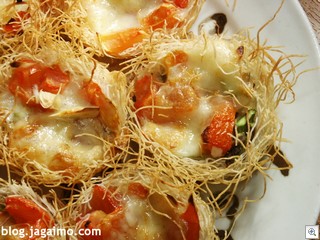Update: For those of you coming from elsewhere, the roundup so far is posted here. Please send me your entries by Sunday and I can include the procrastinators...
A couple of weeks ago on eGullet, member Hiroyuki noted that May 29 is Konnyaku Day.
5/29 could be read “Go Ni Kyuu” in Japanese, which sounds very roughly like “Konnyaku”. That little dajare, or wordplay, is as good an excuse as any for the Japanese konnyaku farming industry to celebrate the gelatinous products of the devil-tongued root.
Since the non-Japanese blogging world is probably oblivious to such events, I thought it might be fun to invite a few English bloggers to make their favorite konnyaku dish, or try something completely new. It’s a bit short notice, but if you have a blog and you would like to join in, send me a link to your “5/29” celebration anytime from now until May 30. Contact me using the “Email" link at the top of my blog, or just leave a comment below. I’ll round up anyone who participates and include them in a roundup starting on May 29. This will be the first event in a series I’ll call WaFooD, explorations of Japanese cooking ingredients and techniques.
Dengaku Konnyaku with Sansho

What is Konnyaku? Wikipedia says it’s a tuber valued for its starchy corm, which still leaves me bewildered, and I actually cook with konnyaku relatively often. I guess I must not spend a lot of time with corms.
You might be surprised to find out that konnyaku’s starch is processed much the same way that corn for making tortillas or hominy is treated: subjected to some torture by limewater, the starches from the plant are apparently converted to something magical.
Insanely gelatinous, but relatively low in calories on its own, konnyaku is popular in Japan as a diet food. People believe that it expands in their stomach and keep them feeling full, though I suspect most of that expansion has happened already when it’s processed. I'm not really into food as medicine; for me, it's just another fun ingredient.
Popular applications include blocks of konnyaku which can be used for dengaku konnyaku or any number of other treats, thinly sliced konnyaku for “sashimi”, tied konnyaku for oden or nimono (poached, simmered dishes), noodles called shirataki popular for one-pot meals called nabe. In Taiwan, some manufacturers have turned konnyaku into yet another vegetarian "meat."
Sometimes konnyaku is processed into sweet confections with fruit flavors, but a skittish FDA forced recalls after discovering cases of a dozen or so people that carelessly swallowed the snacks whole and choked. The remaining products in that category were reformulated, and the remaining examples of those products in the US barely have any konnyaku in them. I guess Jello Jigglers weren’t considered dangerous, but these mysterious foreign vegetable products had to be stopped!
Eat small bites, but be adventurous! A few extra grams of fiber can’t hurt you.
OK, get in touch with me and tell me about your konnyaku creations. They can be Japanese-style, fusiony, or adapted to your local cuisine. If you’ve got photos, even better! See you May 29…
To make it easier to find you, you may also include a technorati tag for WaFooD in your post, just like below:
Technorati: WaFooD












